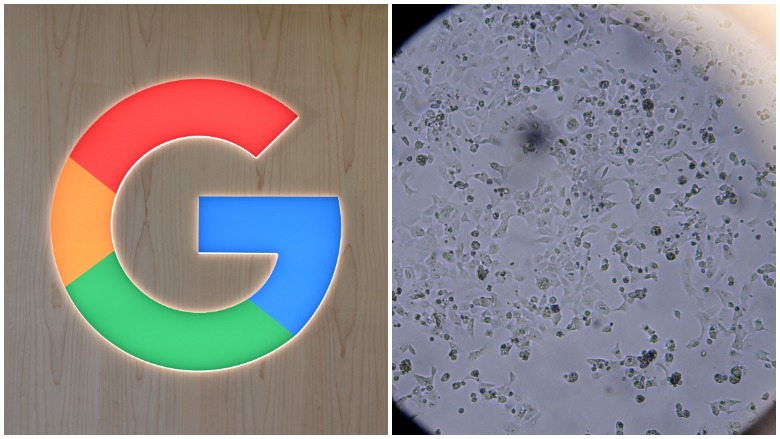
Getty Google (left) and coronavirus, as seen through the microscope of a British scientist (left).
Google announced that it will begin pulling in data from multiple sources and using color-coding to signify coronavirus hotspots as part of its navigation functions. The new feature will appear on Android and iOS systems after the app updates; that update is expected to take place any day now.
Google has also made other changes recently, rolling out a wildfire boundary feature last month as The Verge reported and announcing on September 25 that it would ban all election-related ads from running on any of its platforms, including YouTube after election day, as Axios reported.
Google Maps was, by far, the top-most-used navigation app with 154.4 million monthly users in April of 2018, according to Statistica.
The New ‘COVID Layer’ Feature Will Be Active in 220 Countries, Google Says
In a blog, Google Maps Product Manager Sujoy Banergee wrote that the company was introducing what it is calling a “COVID layer” that gives data on coronavirus concentrations in a number of ways:
- A “seven day average of new COVID cases per 100,000” in an area
- An indicator showing how cases are trending (up, down, etc.)
- Color-coding to indicate density of new cases
Banergee wrote that, “Trending case data is visible at the country level for all 220 countries and territories that Google Maps supports, along with state or province, county, and city-level data where available.” The data will come from a combination of data from Johns Hopkins University, The New York Times and Wikipedia and the app will provide data down to the city-level, where available.
The feature can be activated by opening the Google Maps app, clicking on the layers button in the top right corner, and clicking on “COVID-19 info.” The update, according to Banergee, will start rolling out this week.
Google Unveiled a New Feature Showing the Boundaries of Fires
Google recently updated its appearance of Google Maps last month with more detail easily readable terrain functions, as CNN reported. Last month, Google also unveiled a new feature that would show fire boundaries, according to The Verge. It is an expansion of a feature that was already functioning last year exclusively in California.
The feature works by typing in the name of a current wildfire into Google’s search engine, which will then populate a map showing the fire boundary. Google Maps will also feature road closures and an alert will pop up if they are searching in an area affected by wildfires.
According to The Verge, the idea came about when Google’s Vice President of Engineering, Yossi Matias, noticed smoke blowing outside his office window in Haifa, Israel and discovered that nothing came up when he googled Mount Carmel fire.
The feature came in handy as multiple ferocious wildfires have roared across the country’s western states over the past several days — 26 occurred in just the last six days, according to California’s Wildfire Report. In the state’s fire summary, they reported that 3.6 million acres had been burned and 8,000 wildfires had occurred in the state since the beginning of the year. Since August of 2015, 26 people have died since August 15 and 6,600 buildings have been affected.
According to California’s Climate Change Assessment, California’s heat-related deaths would double or triple by 2050 and the instance of extreme wildfires would increase by 77% by 2100 if greenhouse gas emissions were to continue at the same rate.
Abby Browning, the chief of the private sector office at California’s Office of Emergency Services, said at a press call with Google that information is key in combatting wildfires. “We’re all on edge, we don’t know what’s happening, we don’t know what tomorrow is going to bring. The best thing to calm anyone’s anxiety, to help anyone, is information,” she said, according to The Verge.
Google Is Banning All Post-Election Political Ads
Unlike some other high-profile social media platforms, such as Facebook and Twitter, Google has mainly stayed under the radar as questions have swirled around how big tech will handle misinformation during the 2020 presidential election season.
Google announced September 25, that it would block any political ads from being shown after the election, according to Axios. The tech giant sent an email, Axios reported, saying that it was preventing advertisers from running ads “referencing candidates, the election, or its outcome, given that an unprecedented amount of votes will be counted after election day this year.”
Politico reported that Facebook also said that it was banning ads one week before election day and any after election day in an attempt to avoid misinformation being spread about the election results.
READ NEXT: Extra Unemployment Benefits: Will You Get $1,800?
